Good composition basically builds itself. The biggest mistake that inexperienced painters do when they are building a composition is that they work on one area of the painting until they finish it. Doing that leads to confusing and inconclusive painting since each area of it has separate and unconnected tone and color.
It is very important that you try to build your painting simultaneously, never lingering too much on just one area of it. Go from the front plane to the background adding details to every area as you paint and let your composition to build itself.
Observe your model all the time while painting and look for a way to make colors and shapes be in harmony with each other. Painting is a continuous process of balancing, judging, changing the elements of the painting, that is what makes it so appealing.
Building
If you add too many thick layers of paint too early you might find that you clogged the surface and that all you get is smooth mixed paste. In order to avoid that you need to plan your actions in the early stages. Do not make the mistake of trying to get to finished painting quickly. Start your painting with large brushes and vague shapes and end it with a small brush and details.

Balcony With Flowers
In order to paint this you will need the following:
- Primmed canvas
- Round Sable bristle brush number 3
- Round Hog bristle brush number 4
- Round Hog bristle brush number 6
- Odourless mineral spirits
- Refined linseed oil
- Dammar varnish
You will also need the following oil colors:
Raw Brown, Raw Sienna, Burnt Sienna, Cadmium Orange,
Ochre Yellow, Chrome Green, Cadmium Red, Alizarine Red, Titanium White, French Ultramarine, African Black, Viridian Green, Lemon Yellow, Cobalt Blue and Vermilion.
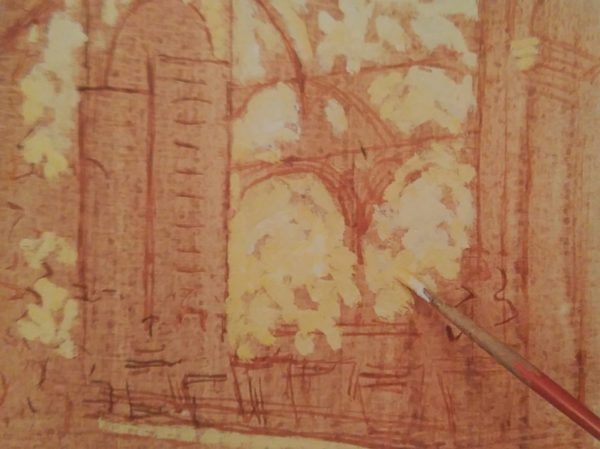
Sketching
Prepare the canvas in advance by toning it with warm brown mixed from Raw Brown and Raw Sienna.
Dilute the paint a lot with odourless mineral spirits and apply it to the canvas using 25mm wide brush.
Leave the painting to dry for 24 hours. When the paint is fully dry use round sable brush number 3 to sketch the main contour of the composition using a bit diluted Burnt Sienna.
Start covering the stone wall with golden yellow mixed from various combinations of Cadmium Orange, Ochre Yellow and Titanium White.
Mix the paint with a medium that consists of equal parts of linseed oil and dammar varnish and double amount of mineral spirits. Paint using round hog bristle brush number 6. Add the paint with short moves in different directions letting some brown uncovered here and there.
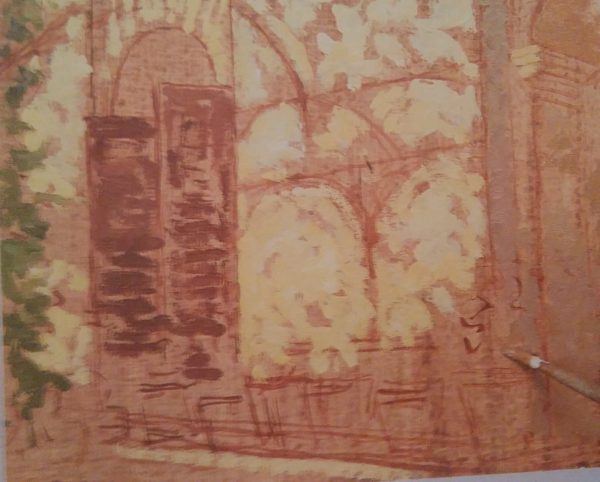
Paint the plant on the left with the mixture of French Ultramarine, Chrome Green and African Black varying in tone from light to dark.
For wooden blinders use the mixture of Burnt Sienna, Alizarine Red and a bit of Cadmium Red.
To paint the part of the wall that is in the shadow on the right you will need Chrome Green, Burnt Sienna, Alizarine Red, Cadmium Red and French Ultramarine.
Mix the colors in different combinations in order to get a strain of tones extending from grey to greyish brown.
Use Burnt Sienna, Cadmium Red, Alizarine Red and white to gain terracotta whit which you will paint the parts of the flower pots that are in the shade.
Paint the arch above the blinders using the same color mixture that you used for the wall in the shade. Use that paint to paint the dotted pattern of the shadow created by the leaves on the bottom left of the painting.
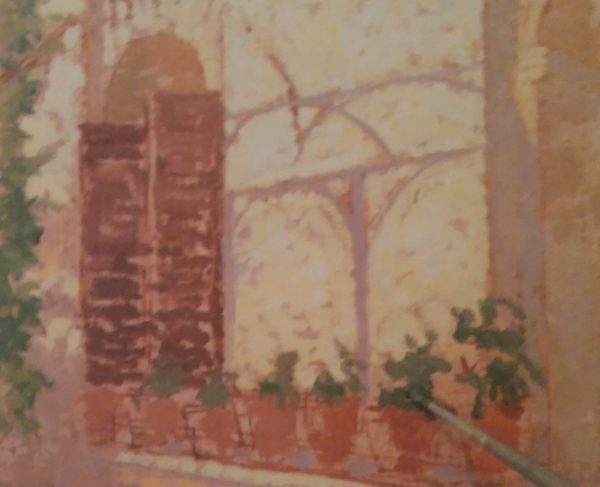
Adding The Details
Continue building a composition with free moves always carefully overseeing the total impression.
Work ore on the wall in the background using the same mixture you prepared for it earlier.
With round, hog bristle brush number 4 paint the shadow on the wall using purple-grey that you gained by mixing French Ultramarine and Cadmium Red.
Add a little bit of Ochre Yellow to the green mixture you already used for the leaves and additionally work on the leaves with it.
Continue painting the wall in the background building it up by adding delicate traces of lighter tone to the shadow using purple mixture you created with added Cobalt Blue and a little bit of white. Use the same color for the spotted patterns of the shadows on both sides of the blinders.
Mix Viridian Green and French Ultramarine for narrow stripes under the flower pots. Add warm light tones to the flower pots using the mixture of Alizarine Red, Titanium White and a bit of Burnt Sienna. Paint the brighter leaves of the potted plants with Lemon Yellow and Chrome Green.
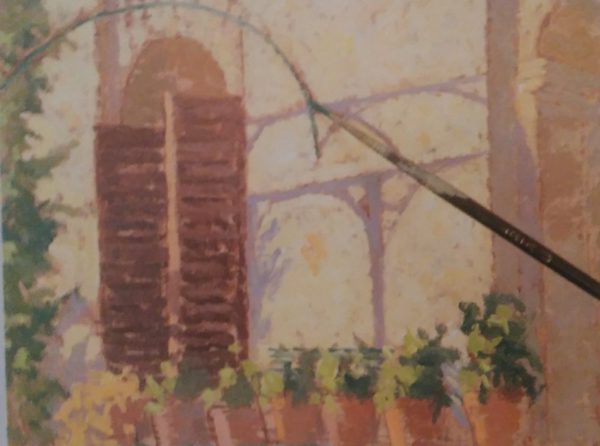
Finishing Touches
Add details to the blinders using the same mixture you used for them before with a little bit of Alizarine Red added for darker areas and a little bit of white added for lighter areas.
For the edge of the blinder where the sun hits it use the mixture of Cadmium Orange, Lemon Yellow and white. Use the same color for the hanging flowers in the left corner of the painting.
Mix Lemon Yellow, Chrome Green and white to paint the leaves with sunlight on them. Using round sable brush number 3 paint the metal arch with the mixture of Viridian Green, French Ultramarine and a bit of white.
Paint a few small branches with leaves in front of the blinders giving your painting a sense of depth and tridimensional space.
Add a few strokes of more saturated paint to the flower pots using the mixture of Burnt Sienna, Cadmium Red and Cadmium Orange. In the end, paint bright red flowers with short moves of Vermilion letting the brush give shape to the petals.
Flowers and leaves are painted by adding thick layers of paint with short moves ower the paint that is still wet making each color change a little bit by the color that is under it.
This is one of many ways of building composition in oil painting. If you have any questions regarding the subject feel free to leave them below and I will be more than happy to answer.



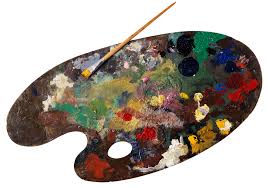
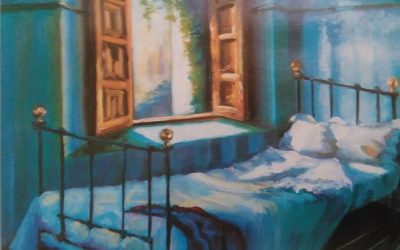
0 Comments